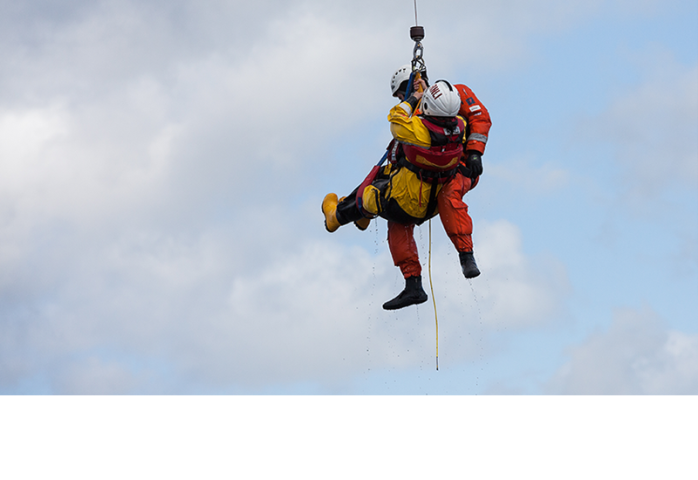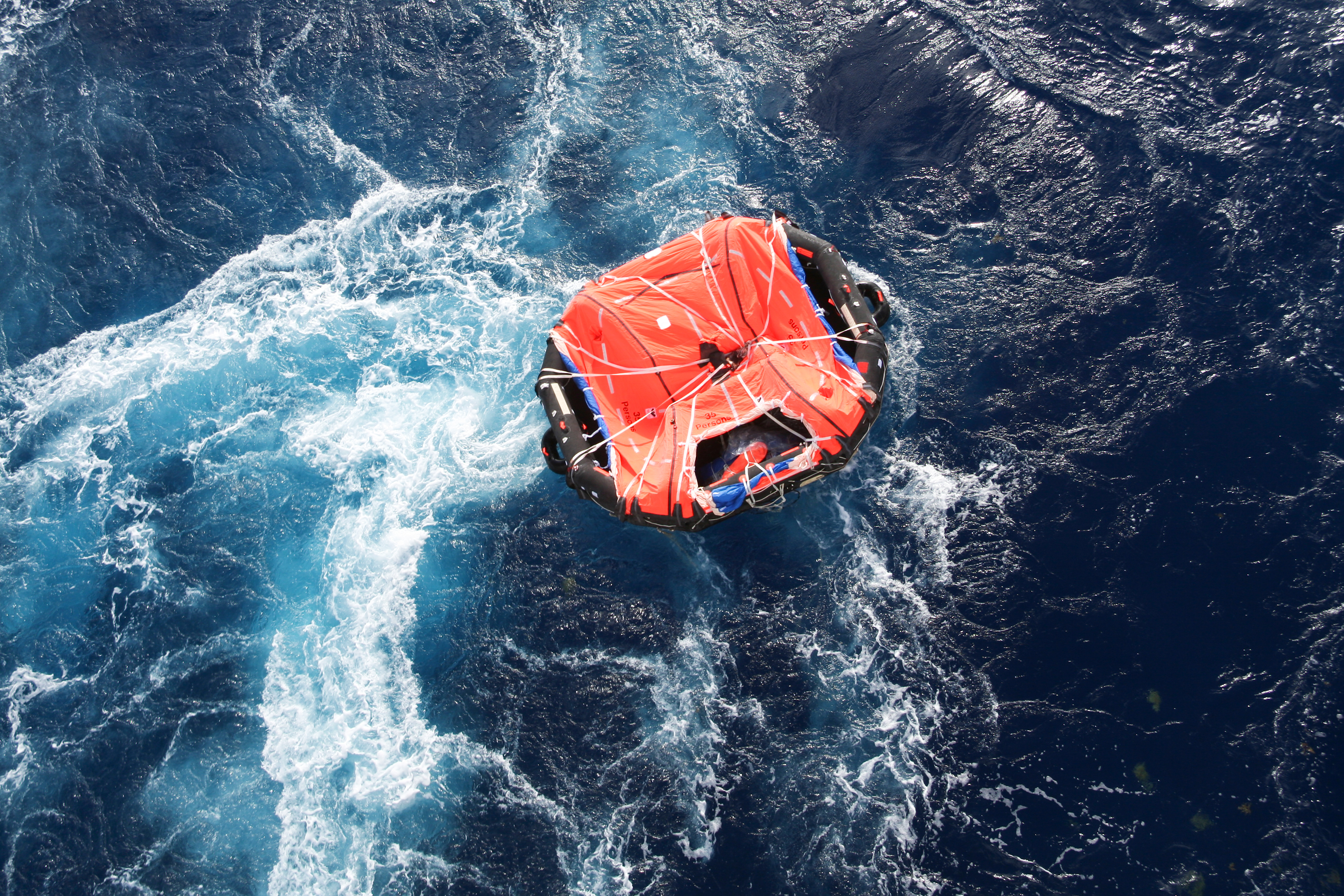
Plastics act as good Samaritans
Polymers against all odds
Sometimes, despite all precautions taken, rescue workers must be called in. At sea or in the mountains, we know that we can count on a competent team with the best rescue equipment. We know this and it is reassuring, but we still have to be able to wait when adverse weather conditions prevent rescue operations from taking place.
At sea, for example, a shipwreck does not always occur a few hundred metres from the coast and once the distress signal has been sent out, it can be several days before rescue workers are able to get to the scene of the incident. In the meantime, if the ship sinks, the shipwrecked have no choice but to take refuge in a lifeboat, which is also on the list of mandatory equipment for any ship venturing out onto the high seas.

|
The lifeboats have changed so much over time, they are a far cry from those that were on the Titanic. Modern lifeboats easily fit inside a large suitcase; they can simply be thrown overboard and will inflate in just a few seconds. The largest lifeboats can hold up to a dozen passengers and resemble a children's inflatable pool. The most innovative lifeboats, such as those designed by the French Plastimo company, comprise of a double envelope. The external envelope is made of reinforced PVC, a polymer capable of withstanding the abrasion caused by the friction of sea salt. The inner envelope is made of flexible polycarbonate, an ultra-watertight material which can stretch up to 500% of its initial size - an essential property because it is easy to imagine the impacts endured by the lifeboat when a dozen people rush into its protective enclave at the same time. As for the bottom, it consists of a thin layer of aluminised polyurethane foam, a foam flexible enough to be folded when the lifeboat is in its suitcase and that ensures proper thermal insulation above all. Finally, the roof and poles are also made of PVC. With such materials, these lifeboats offer almost indestructible shelter for days on end and that is good because they are designed precisely for that purpose!
The most cautious (or anxious) sailors can also complete their equipment with a survival suit, a real individual floatation device. Neoprene and polyurethane-coated polyamide are used to craft the suits. In order to be certified, these suits must guarantee a maximum decrease in body temperature of 2° C during 6 hours in waters between 2 and 0° C.
Plastics to the rescue of rescue effortsRescue workers all have the same creed: providing assistance without putting oneself in danger, or at the very least while minimising risks. Rescuing a shipwrecked individual drifting in rough seas cannot be improvised, and there are many accounts of the tragic disappearance of rescue workers. This was all the more true up until the 1960s, when rescue workers only had wooden lifeboats that behaved rather poorly on the sea. However, it was in the 1950s that the first so-called semi-rigid inflatable lifeboats appeared. |

Thanks to the flexibility offered by plastic materials, semi-rigid lifeboats are able to withstand high waves. That is why they have been adopted by all rescue workers throughout the world. |
Given that they were initially given a lukewarm reception by rescue workers who did not at all trust these plastic lifeboats, the promoters of the semi-rigid lifeboats had to make many demonstrations of their usefulness, sometimes taking incredible risks, in order to prove the superiority of their lifeboat.
Their perseverance ultimately paid off as lifeguards from all over the world abandoned the rigid wooden lifeboats. Semi-rigid lifeboats are so called because they are made up of a rigid shell, now made of polyester or Kevlar, on which is mounted a pneumatic belt in the shape of a large sausage.
The belt is most often made of PVC or polyurethane, resistant polymers that are nevertheless sensitive to UV rays. However, quite effective anti-UV coatings are available. This type of lifeboat is able to cope with waves extremely well, even when the sea is raging. The reason for this is simple: the plastic sausages provide enough flexibility for the boat to adapt to the shape of the steepest waves.
A recently-incorporated French company has developed a rather original and autonomous emergency device. It is a kind of inflatable PVC and polyethersufone drone that looks like a large surfboard which can be launched from the beach or a boat to pick up a person overboard. Its autonomy is still only partial since it must be remotely controlled, but it should soon become fully independent using satellite guidance or a simple AIS beacon.
This invention is currently of interest to beach rescuers because the power of its water jet engine enables it to reach speeds of up to 10 knots (+/- 18 km/h) and it can be launched into the water in just a few seconds. Large enough to save a reckless swimmer swept away by the current!
Polymers coming in loud and clearAlthough the equipment used by rescue workers at sea is impressive, that used by their colleagues in the mountains is no less remarkable. The risks encountered in the mountains are different and rescue workers must most often intervene after a mountaineer has fallen from a height. Although the emergency is similar, the problem is different because it is common for mountaineers to suffer one or more fractures after a fall or even a rockfall. |

In the event of fractures, it is crucial to immobilise the fractured body part. Inflatable plastics make this possible while giving the victim a feeling of comfort. |
The challenge lies in moving the survivor without aggravating their injuries. It is therefore urgent to immobilise the injured person, a common practice. Modern splints are designed to actually and fully block any inappropriate movement; they are inflatable and consist of a layer of polyester for flexibility coated with PVC for strength. Inside, there are thousands of polystyrene beads whose role is to fully block the broken limb in the same way as cement would do. Minus the weight, of course. For more serious cases, such as cervical or vertebral spine trauma, there is an even more advanced splint system that prevents any movement of the back. They are also inflatable but instead of polystyrene beads, they are lined with polyester slats to increase rigidity.
Once immobilized, all that remains to be done is to evacuate the victim. Whether by land or by air (most often by helicopter), they must be laid down in a stretcher. While there are different models, all are designed in more or less the same way. They consist of a shell made up of a tubular metal structure embedded in a glass/polypropylene fibre composite selected for its very high resistance to perforation, bending and abrasion. A polyamide cover is generally used to wrap up the victim in order to isolate them from the cold and wind. Finally, polyester straps are used to hold the injured person and thus prevent them from falling again. This very efficient type of nacelle is certified for use in helihoisting operations.
Of course, we have evoked relatively extreme and fortunately quite rare cases. That being said, whether you are at sea or in the mountains for your holidays, polymers watch over you to ensure that those moments of relaxation remain just that. Happy holidays.





